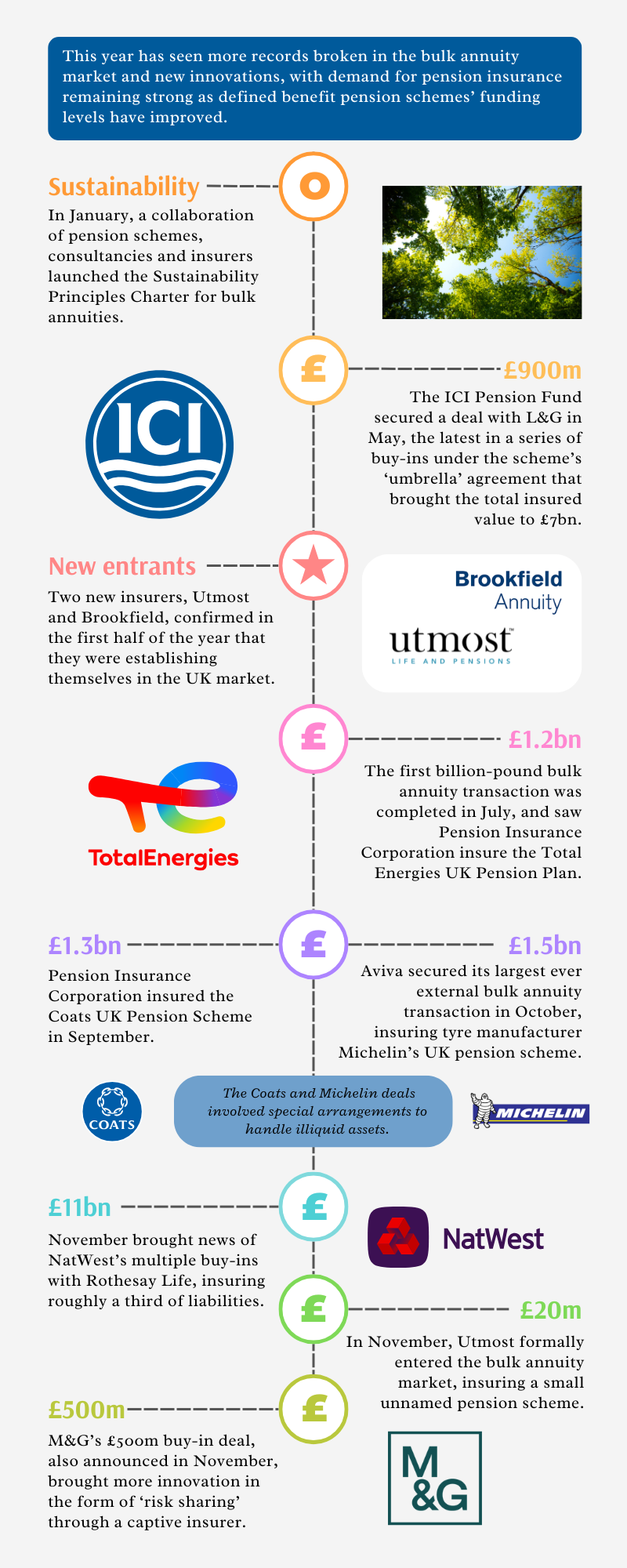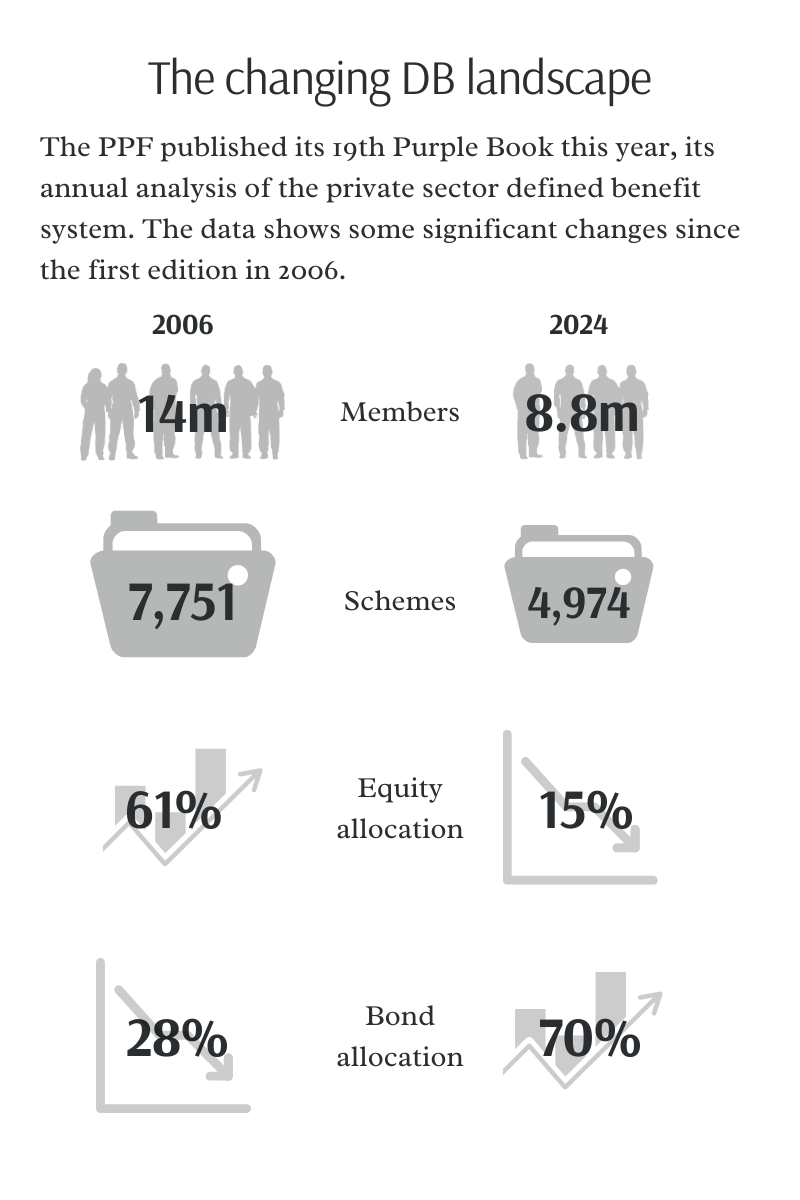From an evolving bulk annuity market to debates over the use of pension scheme surpluses, next year looks set to be as busy as ever for the defined benefit sector, writes Alex Janiaud.
At the halfway point of 2024, consultancy Barnett Waddingham said that the bulk annuity market was set for another record-breaking year.
Last year marked a record high of bulk annuity volumes, which registered at £49.1bn.
Deals such as Rothesay’s £6bn agreement to buy Scottish Widows’ back book were highlights of a first half that also witnessed some delays to large transactions, but Barnett Waddingham nevertheless predicted a strong finish to 2024 with full-year volumes forecast “to comfortably exceed £40bn”.
Others were more bearish. Figures from XPS showed that the market for large bulk annuity deals had slowed in the first half, and the consultancy said that 2024 could end up recording lower transaction volumes than the prior year.
“We’ve had a very buoyant small and mid-market level of activity, so record numbers of transactions there,” says Aon senior partner Martin Bird. “We’ve had much more activity at or around the £1bn market”, he continues, predicting year-end volumes of around £50bn.
The bulk annuity market looks set to be shaken up by the entrance of two new players: Brookfield and Utmost. Royal London, meanwhile, entered the market in March with two deals with its own defined benefit (DB) schemes worth around £650m.
M&G, which re-entered the bulk annuity space last year, is making waves with its innovative ‘risk-sharing’ buy-in offering.
“It’s great for the market,” says Bird of the new options. “I think that will, certainly in the near-term, fuel a lot of activity in the small and medium sector.”
Highlights from 2024: bulk annuities

Surplus is an emotive topic
UK DB funding levels are generally strong. As of 28 February and based on assets of £1.42trn and liabilities of £1.27trn, the aggregate funding level of UK pension schemes on a long-term target basis sat at 112% of the long-term value of liabilities, according to XPS.
The Pension Protection Fund’s (PPF) latest Purple Book data shows that there is a total estimated surplus of £219bn across the private sector DB universe.
Healthy funding levels could tempt legislators to rework rules governing sponsor access to scheme surpluses.
“The topic of surplus can lead to very emotive discussions for trustees and sponsors,” says Zedra client director Alan Greenlees.
“A further reduction or removal of the tax on surplus withdrawal would be seen by many as a welcome change. However, it is difficult to see if the Treasury would support any such change that would reduce tax receipts in this current climate.” - Alan Greenlees, Zedra
“At present, the rules around surplus and who can access that are very much scheme-specific and frustratingly can vary quite considerably,” he continues. “It will be interesting to see if central rules are changed to make surplus more accessible for sponsors.”
He adds: “The taxable rate on surplus repayments will also need to be considered.” This was already reduced downwards from 35% to 25% in April 2024.
“A further reduction, or removal of this tax entirely, would be seen by many as a welcome change. However, it is difficult to see if the Treasury would support any such change that would reduce tax receipts in this current climate.”
Pensions Expert spoke to lawyers earlier this year on the surplus issue, some of whom urged caution on the ambitious aims and highlighted that it should still be used primarily as a reserve for paying member benefits.
The consolidation debate rumbles on
The PPF’s surplus may also attract further scrutiny in 2025. It reported a £14bn surplus as of 31 March 2024 in its latest annual report, based on liabilities of £19bn and assets of £32bn.
“Everyone looks at the massive surplus that the PPF has been running and everyone wants to get their hands on it, one way or another, and consolidation is one potential way for it to get spent,” says Cartwright senior investment consultant Yona Chesner.
“You’ve got to be really careful at how you design that,” he cautions.
Lara Desay, head of risk transfer at Hymans Robertson, believes that a public sector consolidator “could be another valuable tool to help members whose benefits may otherwise be at risk”.
“Commercial consolidators can offer a lower entry price than insurers by offering less security,” she says. “In contrast, a state-backed consolidator is likely to have access to more capital at a lower cost than commercial entities – so it has the potential to be stronger than an insurer and cheaper than a superfund.”
The previous government consulted on whether the PPF should be allowed to enter the consolidation space, and the Labour government has taken this forward. It is expected to publish a response to the consultation in the new year, meaning 2025 could be a year of major change for the lifeboat fund.
The PPF’s chief investment officer Barry Kenneth, speaking at an industry event earlier this year, expressed confidence in the organisation’s ability to succeed with an expanded remit.
“We will need to demonstrate delivery, scheme investment and administration, and to have a proven track records in these three areas for consolidation,” Kenneth said. “Obviously I’m biased, but we believe that we have that.”






















